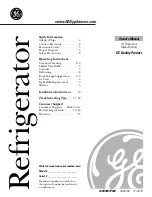
33
32
GB
GB
Store food straight away
Don’t buy frozen food unless you can freeze it straight away� Special insulated bags can be bought
from most supermarkets and hardware shops� These keep frozen food cold for longer�
Thawing frozen food
For some foods, thawing before cooking is unnecessary� Vegetables and pasta can be added directly
to boiling water or steam cooked� Frozen sauces and soups can be put into a saucepan and heated
gently until thawed�
Freezing fresh food
• Ensure that your freezing operations are carried out under the most hygienic conditions as
freezing alone does not improve the food�
• Never put hot or even warm foodstuffs into the freezer�
• Prior to freezing the food, food should always be covered tightly with foil, plastic film, placed
in plastic bags or stored in airtight containers� This will prevent food from dehydrating and to
prevent any strong odors of some foods transferring to milder ones�
• To freeze raw meat, wrap in plastic bags or in airtight containers and place on the lowest shelf to
avoid cross contamination�
• Do not allow raw meat to come into contact with cooked foods� For safety, only store raw meat
for two or three days� Fruit and vegetables should be thoroughly cleaned and placed in the
crisper�
• Milk and other liquids should be sealed with lids and placed in the bottle shelf in the door�
NOTE:
The ambient temperature of the freshly stored food and how often the door is opened affect
the temperature in the refrigerator� If required, change the thermostat temperature settings�
Storing frozen food
• All frozen food you purchase should be placed in the freezer as soon as possible to avoid them
from defrosting and spoiling�
• All storage recommendations printed on the packaging of frozen food by the manufacturer
should always be followed�
• When using the freezer for the first time or after defrosting, set the thermostat knob to the
maximum position for at least 2 hours before introducing food to be stored, and then readjust it
to the normal position�
Recommended storage periods
For recommended food storage time, refer to the Storage Guidelines on the packaging� You will be
able to store each item of food for the period shown� This is usually the period stated as “Best, Before”,
found on the front of the packaging�
Making ice cubes
1� Fill the ice tray with ¾ full of clean water�
2� Place the tray in the top freezing drawer�
3� Close the door�
To remove the ice cubes from the tray, put the tray under running water for a while and then twist
the tray slightly to loosen the ice cubes�
Energy-saving tips
• Install the fridge or freezer in a cool place out of direct sunlight and away from cookers, heaters,
dishwashers or any hot air emitting items�
• Do not set the fridge and freezer temperatures lower than necessary� Set the internal
temperature within the correct range e�g� adjust the thermostat at middle position for 4°C in the
fridge compartment and -18°C in the freezer respectively�
• Let pre-cooked foods cool down before placing them in the fridge or freezer� This will prevent
the internal temperature of the fridge from rising�
• Keep your fridge full, but not over crowded, this helps reduce «cold» air loss� Meanwhile, avoid
overloading the fridge or freezer� Try to leave about 20% free space for air circulation�
• To prevent cold air escaping, limit the frequency of opening door� When retuning from shopping,
sort foods to be kept in your fridge before opening the door� Only open the door to put food in or
take it out�
• Make sure the door seal is clean and in good condition� It should hold a piece of paper tightly in
place when shut�
• Defrost regularly or when ice is more than 5mm thick� Thick ice covering the inner sides
significantly increases energy use�
• The combination of the drawers, baskets and shelves shown in the device description is optimal
for efficient energy savings� Changing the combination proposition could alter the efficiency�







































